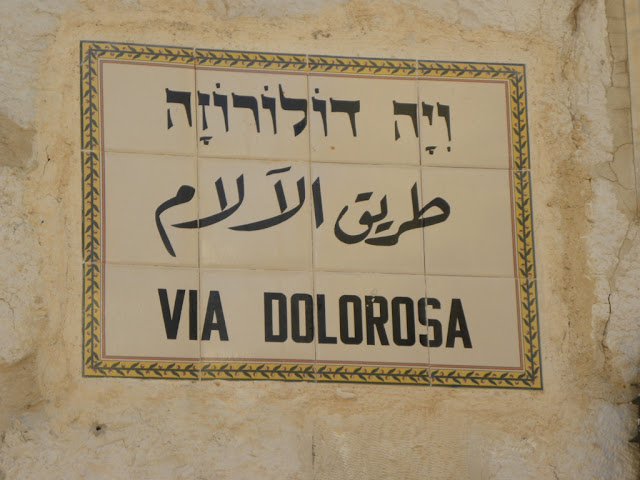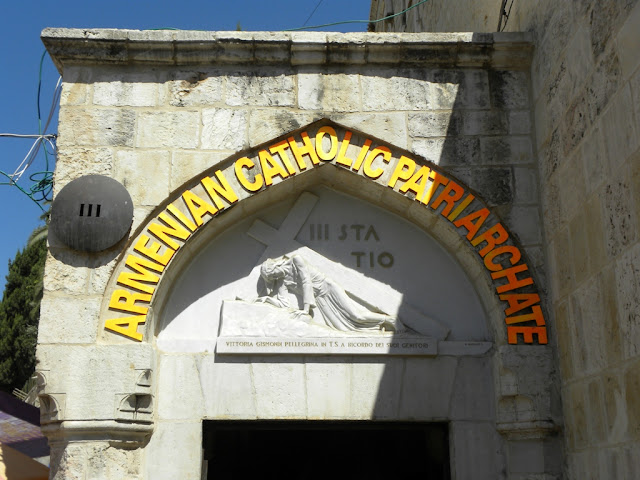The 1st and 2nd station don’t exist anymore but it was here that Pontius Pilate in the Antonia Fortress condemned Jesus to be crucified. Jesus wearing a crown of thorns took up the cross and started his climb to the hill of Golgotha. Many Christian believers walk the Via Dolorosa to visit the stations and some of them also carry a cross and read from the bible. We started our walk at the 3rd station were Jesus fell for the first time. At the 4th station, Jesus sees his mother Maria and they acknowledge each other. At the 5th station, a Cyrenian helps Jesus to carry the cross. At the 6th station Veronica cleans the face of Jesus with a veil. At the 7th station, Jesus falls again and the Romans have no mercy. They fear that he would die here. They help him because he should die during the crucifixion. At the 8th station, Jesus comforts the crying women of Jerusalem saying don’t weep for me but for yourselves and your children. At the 9th station Jesus falls again, he can already see the place where he is going to be crucified. The Via Dolorosa is now in downtown Jerusalem, when these events took place this was already outside the city borders. Because of the historical significance of the next events, the following articles are split and describe: The church of the Holy Sepulcher, the Crucifixion, the Stone of Unction, and the Tomb of Jesus. For many people walking this route have difficulties keeping their emotions under control.
Het 1st en 2de station bestaat niet meer, het was hier dat Pontius Pilate in het Antonia Fort, Jezus veroordeelde tot kruisiging. Jezus die een kroon met doorns droeg tilde het kruis op en startte zijn klim naar de heuvel van Golgotha. Vele gelovige Christenen wandelen dezelfde route van de Via Dolorosa om de stations te aanschouwen. Sommigen van hen dragen ook een kruis met zich mee en lezen voor uit de bijbel. Wij starten onze tocht aan het 3de station waar Jezus voor de eerste keer viel. Aan het 4de station ziet Jezus zijn moeder Maria en ze hebben oogcontact. Aan het 5de station helpt iemand Jezus met het dragen van het kruis. Aan het 6de station veegt Veronica met een doek het gelaat van Jezus schoon. Aan het 7de station valt Jezus terug, maar de Romeinen kennen geen genade en helpen hem, hij mag hier niet sterven, dat moet aan het kruis gebeuren. Aan het 8ste station, troost Jezus de vrouwen van Jeruzalem, hij vraagt hen niet te wenen voor hem maar voor zichzelf en hun kinderen. Aan het 9de station valt Jezus terug en ziet hij de plaats waar hij gekruisigd zal worden. De Via Dolorosa ligt nu midden in de stad van Jeruzalem, maar toen dit gebeurde waren we reeds buiten de stadsgrenzen. Vanwege de historische belangrijkheid van de daaropvolgende gebeurtenissen, splitsen we de volgende artikelen op in: de Kerk van het Heilige graf, de Kruisiging, de Steen van de Zalving, en het Heilige Graf van Jezus. Voor vele mensen die deze route wandelen wordt het moeilijk om hun emoties te bedwingen..










Our travel articles related to the important historical places in the “Life of Jesus”:
1. The Basilica of the Annunciation, Nazareth
2. The House and carpentry of Joseph in Nazareth underneath the Saint Joseph church
3. Grotto of the Nativity - Why Bethlehem instead of Nazareth? The flight to Egypt.
4. Capernaum in Galilee, the Town of Jesus.
5. Baptismal site in the Jordan River where John baptised Jesus.
6. Sermon on the mount, our visit to Mount of Beatitudes.
7. Tabgha, the miracle of the loaves and the fishes.
8. The Mount of Olives, one of the must important places for Jesus and the Jews.
9. The Basilica of the Agony, the evening before the arrest of Jesus.
10. An emotional visit on the Via Dolorosa where Jesus carried the cross.
11. Touching the rock on which Jesus died, the church of the Holy Sepulchre.
12. The Stone of Unction in the church of the Holy Sepulchre.
13. The Tomb of Jesus and the Resurrection, Church of the Holy Selpuchre.
Return to main page












lovely shots.
ReplyDeleteI wish people would care more about his teaching of compassion!
Aloha from Waikiki;
Comfort Spiral
> < } } ( ° >
Beautiful impressions from the stones and doors and the process of crucifixion from Jesus. Thanks for sharing !
ReplyDeleteWow. I was slightly taken aback when I saw the Arabic script. But it made sense when I saw Israel. I seem to have missed that the first time around. MY experiences with Basilicas have been just as charming and mostly within Italy.
ReplyDeleteThat must be real "something" imagining Jesus in painover there a couple of thousand years back!
ReplyDeleteFascinating post with wonderful images. To walk in the steps of ancient times, in the place where Christianity began must have been inspiring. Beautiful!
ReplyDeleteindeed very beautiful details you have captured in your pics...what was your favourite encounter/place in Israel btw?! fijne weekend!:-))
ReplyDeletewow wonderful images in your post
ReplyDeletegretting from java
Seeing this makes me a bit speechless. Can only imagine the feelings that a person of faith would have carrying a cross in this time and thinking back to the power of this place which has lasted over the centuries, and still has so much power
ReplyDelete